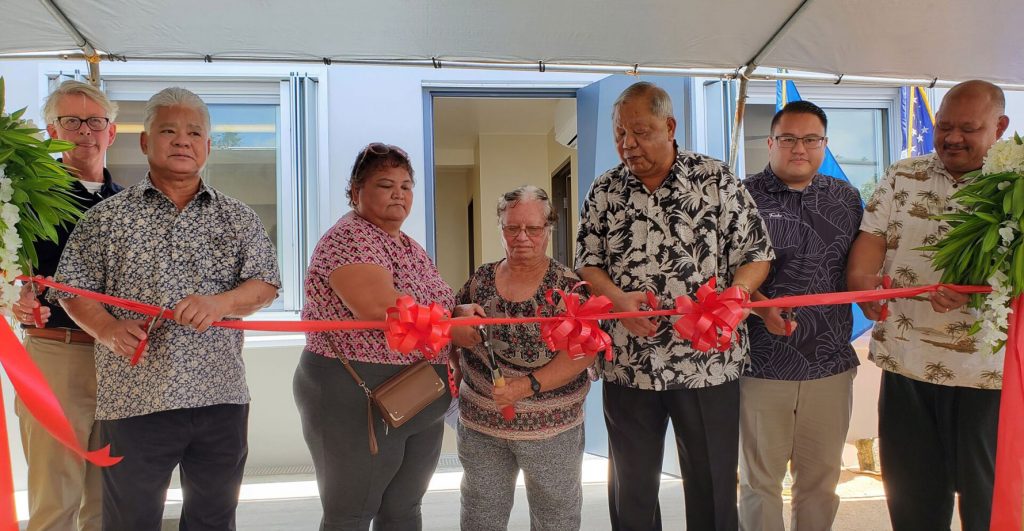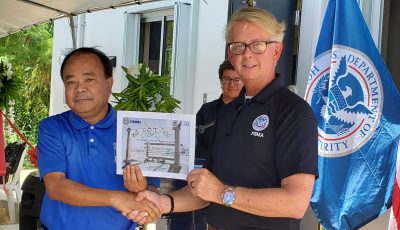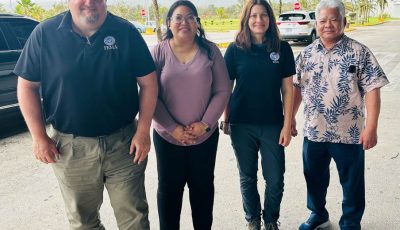FEMA turns over 179th completed new house

Gov. Arnold I. Palacios, second from left, and Lt. Gov. David M. Apatang, third from right, lead the ceremonial ribbon-cutting for the completion of the 179th new home built under the Federal Emergency Management Agency’s Permanent Housing Construction Program, in Chalan Kanoa yesterday morning. Also in the photo are FEMA Long Term Recovery Office director Wayne “Randy” Clayton, extreme left; homeowner Joaquina Agulto, fourth from left; Agulto’s daughter Ana Lizama, third from left; Rep. Manny Castro (Ind-Saipan), second from right; and Rep. John Paul Sablan (Ind-Saipan), extreme right. (FERDIE DE LA TORRE)
The Federal Emergency Management Agency turned over yesterday morning the keys to the 179th newly constructed home it built as part of a program to assist homeowners who lost their homes in the devastation of the Category 5 Super Typhoon Yutu in October 2018.
Gov. Arnold I. Palacios and Lt. Gov. David M. Apatang joined FEMA officials at a ribbon-cutting ceremony commemorating the end of FEMA’s Permanent Housing Construction program at the final turnover of the new home in Chalan Kanoa, Saipan.
Joaquina Agulto’s home, located on Pedro Avenue and Chalan Tun Joaquin Doi Road, is the 165th new home built on Saipan under the PHC Program, which is a FEMA program that builds a home completely for free. Fourteen other new homes were also completed on Tinian. In total, 101 households (93 on Saipan and eight on Tinian) also received direct repairs under the program.
FEMA approved the PHC Program on Nov. 16, 2018, to support the high demand for housing solutions at that time following Super Typhoon Yutu’s widespread devastation on Saipan and Tinian. Yutu is considered the strongest typhoon ever recorded to hit the CNMI.
FEMA handed yesterday a certificate of appreciation to one of their leading contractors, Ruel Villacrusis, owner/general manager of RNV Construction, in recognition for “a job well done.”
The project has had several delays in obtaining permits because it is located on a wetland, which was deemed biologically and archeologically sensitive.
The new house is compliant with the Americans with Disabilities Act—it has front door ramp, wider doors, shower bench, bathroom grab bars, lowered cabinet, lowered sinks, lowered light switches, lowered electrical panels, and lowered peep holes.
The roof and exterior are designed to withstand 195 miles per hour winds. The locking aluminum hurricane shutters are designed to withstand 195 mph winds, and are impact resistant.
In his remarks, Palacios said this completion of a new home signifies a major step toward full recovery from Super Typhoon Yutu’s devastation in 2018.
Palacio said he and Apatang grew up in District 1, just a couple of blocks from Agulto’s house, so they know who it belongs to.
“It’s really nice to come back to the neighborhood,” said the governor, who recognized Rep. John Paul Sablan (Ind-Saipan) “for taking care of the village.”
He also recognized Robert Pesapane, who is the FEMA Region 9 acting director for Public Assistance Division, for his virtual presence at the ceremony.
Palacios said the completion of the final home under FEMA PHC is a testament to FEMA’s and the CNMI’s collective resilience and resolve to get things done.
The governor extended his gratitude to FEMA Region 9 leadership, especially to regional administrator Robert Fenton and Pesapane, who, along with FEMA Long Term Recovery Office director Wayne “Randy” Clayton, ensured the program’s success.
“We look forward to your continued support as we progress with our public assistance and hazard mitigation programs,” he said.
Palacios also thanked local government agencies whose partnership with FEMA has been crucial in the success of the mission.
Through their combined efforts, nearly $1 billion has been allocated for the CNMI’s recovery, he said.
“On behalf of the entire CNMI community, the lieutenant governor and myself, I extend our deepest gratitude to all individuals and organizations involved,” Palacios said.
In her welcoming remarks, FEMA External Affairs officer Veronica Verde said they recognize the significant steps taken by the CNMI in implementing mitigation and resilient measures to protect the community against future disasters.
Verde said the CNMI made a strategic decision to adopt the 2018 International Building Code, ensuring that new homes and repairs would meet the highest standards of durability and resilience. She said these measures were put into action following the devastating impact of Super Typhoon Yutu in 2018 and they serve as a testament to the commitment of the CNMI to safeguard the well-being of its residents.
In his opening remarks, Clayton said it seems to be a long time in coming, but they have been developing and implementing the housing mission since 2018 with extraordinary leadership, engineering design, construction codes, environmentally sensitive properties and permitting achievements.
Clayton said Agulto’s home, which they fondly referred to as “Project 1928,” deserves much attention for overcoming many environmental hurdles such as its wetland location, endangered species protections, and onsite property sanitation/septic system like the vegetative submerged bed.
He congratulated the 66-year-old Agulto, whom he described as their “longest enduring survivor, homeowner, and Permanent Housing Construction applicant.”
“Your patience and perseverance to your alternative housing during this time bears witness to the assurance of things hoped for, your mission of what was not seen until today. …Welcome home,” Clayton said.
Agulto’s daughter, Ana Lizama, said it is indeed a momentous time for her mother. “We are forever grateful in our hearts. And I am sure my mom deeply appreciates every person that [helped] accomplish this…home for my mom,” Lizama said.
She said her mother grew up in the property and that she misses her home.
“I’m sure she will be back in her home starting this day again. It was a long awaiting journey,” Lizama said.
“From our siblings and I, my mom’s grandkids and great grandkids, thank you to everyone in the community, our leadership in the CNMI, our FEMA team in the CNMI, U.S. FEMA team, and RNV Construction,” she said.
In a later interview, Lizama said that Yutu leveled her mother’s semi-concrete house. She said it was only her brother, Geronimo Agulto, who was inside the house at the time.
Geronimo Agulto said that when he felt strong winds, he got really scared so he ran out and stayed for many hours inside an abandoned car located in the back of the house.



























